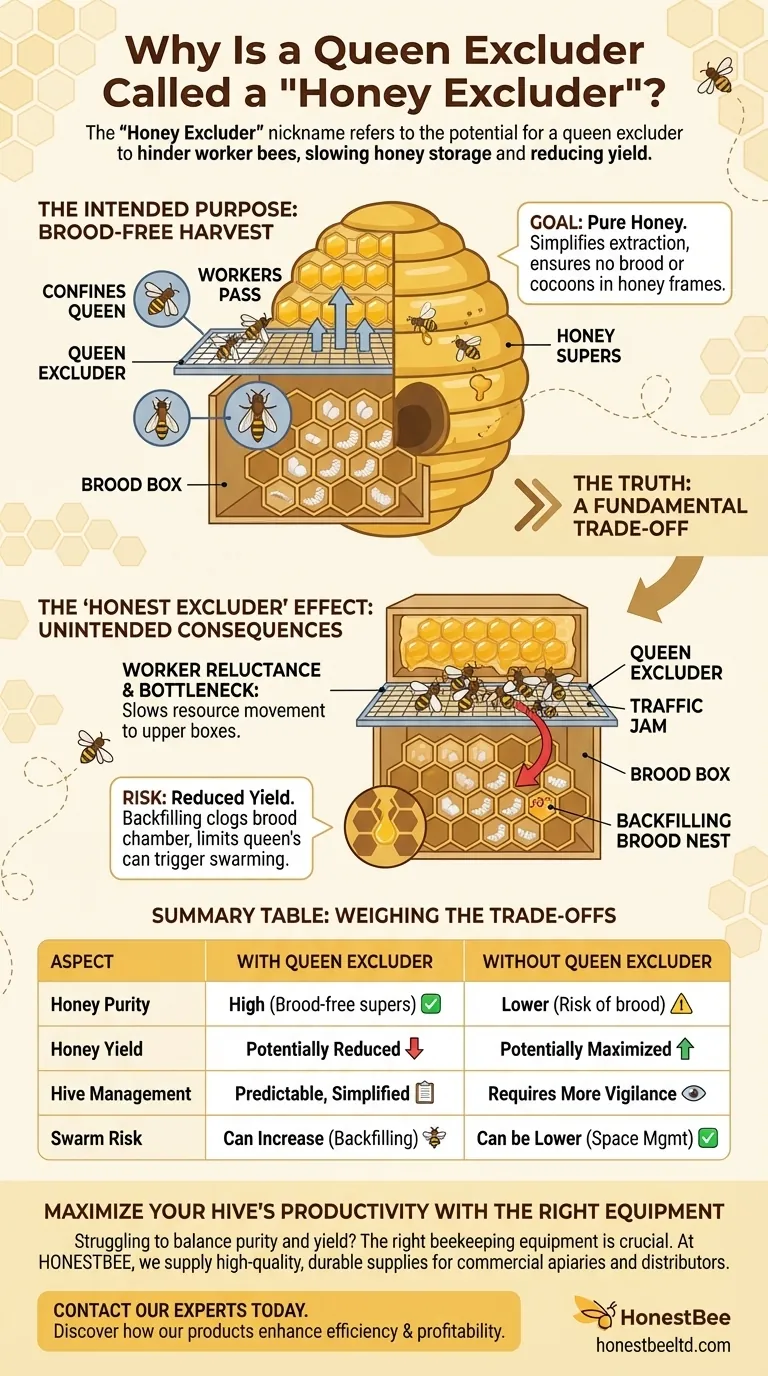The term 'honey excluder' is a nickname for a standard queen excluder, used by beekeepers who believe the device hinders worker bees from moving into the honey supers. This reluctance to pass through the narrow grid can slow down honey storage, effectively "excluding" honey from the harvest and leading to the critical, alternative name.
The queen excluder presents a fundamental trade-off in beekeeping. It guarantees brood-free honey frames, simplifying extraction and ensuring purity, at the potential cost of reducing the hive's overall efficiency and honey yield.

The Intended Purpose: A Brood-Free Harvest
What is a Queen Excluder?
A queen excluder is a simple grid, typically made of metal or plastic, with openings that are precisely sized. The gaps are large enough for smaller worker bees to pass through but too narrow for the larger queen bee.
It is placed between the brood boxes (where the queen lays eggs) and the honey supers (where honey is stored).
The Goal of Pure Honey
The primary function of an excluder is to confine the queen to the brood chamber. This prevents her from laying eggs in the honey supers.
Beekeepers do this because honey harvested from frames that have never contained brood is considered purer and better tasting. It also prevents remnants from hatched eggs, such as dark cocoons and waste, from being incorporated into the wax, which simplifies the extraction process.
The Unintended Consequence: The "Honey Excluder" Effect
Creating a Barrier for Workers
The core of the debate stems from the excluder's physical nature. While workers can fit through the openings, they may be hesitant to do so, especially during a heavy nectar flow.
This creates a bottleneck in the hive's workflow, slowing the movement of bees and resources into the upper boxes where you want the honey stored.
The Risk of Backfilling
When foragers are reluctant to move upward, they will begin storing nectar in the first available space. This is often empty cells within the brood nest itself.
This phenomenon, known as backfilling, clogs the brood chamber with nectar, reducing the space available for the queen to lay eggs.
The Impact on Honey Yield
The combination of worker hesitation and a backfilled brood nest can directly reduce the honey harvest. If the bees aren't efficiently moving nectar into the supers, those boxes will be filled more slowly, or not at all.
It is this direct impact on production that earns the device its critical nickname: the honey excluder.
Understanding the Trade-offs
Pro: Guaranteed Queen Containment
The primary advantage is absolute certainty. With an excluder in place, a beekeeper knows exactly where the brood nest ends and the honey storage begins. This makes hive inspections and honey harvesting much more predictable and straightforward.
Con: Potential for Reduced Efficiency
The central drawback is the potential for a "traffic jam" that reduces the hive's productivity. It introduces an artificial barrier that can interfere with the colony's natural instinct to store surplus honey above the nest.
A Note on Swarm Pressure
A congested brood nest is a major trigger for swarming. By encouraging backfilling, a poorly managed queen excluder can inadvertently increase the colony's impulse to swarm, as the bees perceive they have run out of space.
Making the Right Choice for Your Apiary
The decision to use a queen excluder is not a matter of right or wrong, but of management style and goals. Observing your specific colonies is key.
- If your primary focus is maximum honey purity and simple extraction: Using a queen excluder is a reliable way to keep your honey supers free of brood.
- If your primary focus is maximizing honey yield and you practice active hive management: You might choose to omit the excluder but must remain vigilant about the queen's location to prevent her from laying in your honey supers.
- If you are dealing with a prolific queen or a colony that tends to overproduce brood: An excluder is an invaluable tool for maintaining a well-organized hive structure.
Ultimately, understanding this tool's dual nature allows you to make a strategic decision that best serves the unique needs of your colony.
Summary Table:
| Aspect | With Queen Excluder | Without Queen Excluder |
|---|---|---|
| Honey Purity | High (Brood-free supers) | Lower (Risk of brood in supers) |
| Honey Yield | Potentially Reduced | Potentially Maximized |
| Hive Management | Predictable, Simplified | Requires More Vigilance |
| Swarm Risk | Can Increase (if backfilling occurs) | Can be Lower (with proper space management) |
Maximize Your Hive's Productivity with the Right Equipment
Struggling to balance honey purity with maximum yield? The right beekeeping equipment is crucial for efficient apiary management. At HONESTBEE, we supply commercial apiaries and beekeeping equipment distributors with high-quality, durable supplies through our wholesale-focused operations.
Let us help you choose the right tools for your specific goals. Contact our experts today to discuss your needs and discover how our products can enhance your operation's efficiency and profitability.
Visual Guide

Related Products
- HONESTBEE 6 Frame Three Use Electric Honey Extractor for Beekeeping
- Professional Plastic Queen Excluder for Modern Beekeeping
- 8-Frame Electric Self-Reversing Honey Extractor Spinner for Commercial Honey Extraction Equipment
- HONESTBEE 72 Frame Industrial Electric Honey Extractor for Beekeeping
- electric honey extractor honey centrifuge 3 frame honey extractor stainless steel honey frame extractor
People Also Ask
- What type of honey extractor is best? Maximize Your Harvest Efficiency with the Right Choice
- What is a honey extractor and why is it beneficial for beekeepers? Boost Hive Health & Harvest Efficiency
- What are the size and power variations in honey extractors? Optimize Your Harvesting Efficiency
- What is the basic principle of the honey extractor? Harness Centrifugal Force for Efficient Harvesting
- What is the best type of honey extractor? Find the Perfect Match for Your Beekeeping Scale



















